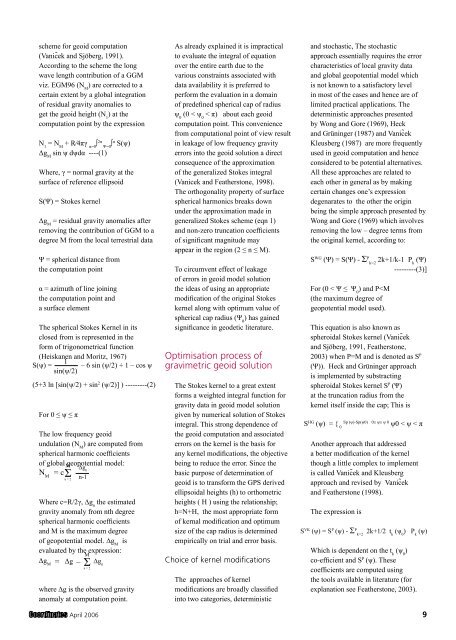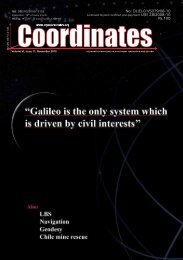Download - Coordinates
Download - Coordinates
Download - Coordinates
Create successful ePaper yourself
Turn your PDF publications into a flip-book with our unique Google optimized e-Paper software.
scheme for geoid computation<br />
(Vanic̃ek and Sjöberg, 1991).<br />
According to the scheme the long<br />
wave length contribution of a GGM<br />
viz. EGM96 (N M ) are corrected to a<br />
certain extent by a global integration<br />
of residual gravity anomalies to<br />
get the geoid height (N 1 ) at the<br />
computation point by the expression<br />
N 1 = N M + R⁄4πγ α=0 ∫ 2π<br />
Ψ=0 ∫π S(ψ)<br />
Δg M sin ψ dψdα ----(1)<br />
Where, γ = normal gravity at the<br />
surface of reference ellipsoid<br />
S(Ψ) = Stokes kernel<br />
Δg M = residual gravity anomalies after<br />
removing the contribution of GGM to a<br />
degree M from the local terrestrial data<br />
Ψ = spherical distance from<br />
the computation point<br />
α = azimuth of line joining<br />
the computation point and<br />
a surface element<br />
The spherical Stokes Kernel in its<br />
closed from is represented in the<br />
form of trigonometrical function<br />
(Heiskanen and Moritz, 1967)<br />
For 0 ≤ ψ ≤ π<br />
The low frequency geoid<br />
undulation (N M ) are computed from<br />
spherical harmonic coefficients<br />
of global geopotential model:<br />
Where c=R/2γ, ∆g n the estimated<br />
gravity anomaly from nth degree<br />
spherical harmonic coefficients<br />
and M is the maximum degree<br />
of geopotential model. ∆g M is<br />
evaluated by the expression:<br />
where ∆g is the observed gravity<br />
anomaly at computation point.<br />
As already explained it is impractical<br />
to evaluate the integral of equation<br />
over the entire earth due to the<br />
various constraints associated with<br />
data availability it is preferred to<br />
perform the evaluation in a domain<br />
of predefined spherical cap of radius<br />
ψ 0 (0 < ψ 0 < π) about each geoid<br />
computation point. This convenience<br />
from computational point of view result<br />
in leakage of low frequency gravity<br />
errors into the geoid solution a direct<br />
consequence of the approximation<br />
of the generalized Stokes integral<br />
(Vanicek and Featherstone, 1998).<br />
The orthogonality property of surface<br />
spherical harmonics breaks down<br />
under the approximation made in<br />
generalized Stokes scheme (eqn 1)<br />
and non-zero truncation coefficients<br />
of significant magnitude may<br />
appear in the region (2 ≤ n ≤ M).<br />
To circumvent effect of leakage<br />
of errors in geoid model solution<br />
the ideas of using an appropriate<br />
modification of the original Stokes<br />
kernel along with optimum value of<br />
spherical cap radius (Ψ 0 ) has gained<br />
significance in geodetic literature.<br />
Optimisation process of<br />
gravimetric geoid solution<br />
The Stokes kernel to a great extent<br />
forms a weighted integral function for<br />
gravity data in geoid model solution<br />
given by numerical solution of Stokes<br />
integral. This strong dependence of<br />
the geoid computation and associated<br />
errors on the kernel is the basis for<br />
any kernel modifications, the objective<br />
being to reduce the error. Since the<br />
basic purpose of determination of<br />
geoid is to transform the GPS derived<br />
ellipsoidal heights (h) to orthometric<br />
heights ( H ) using the relationship;<br />
h=N+H, the most appropriate form<br />
of kernal modification and optimum<br />
size of the cap radius is determined<br />
empirically on trial and error basis.<br />
Choice of kernel modifications<br />
The approaches of kernel<br />
modifications are broadly classified<br />
into two categories, deterministic<br />
and stochastic, The stochastic<br />
approach essentially requires the error<br />
characteristics of local gravity data<br />
and global geopotential model which<br />
is not known to a satisfactory level<br />
in most of the cases and hence are of<br />
limited practical applications. The<br />
deterministic approaches presented<br />
by Wong and Gore (1969), Heck<br />
and Grüninger (1987) and Vanic̃ek<br />
Kleusberg (1987) are more frequently<br />
used in geoid computation and hence<br />
considered to be potential alternatives.<br />
All these approaches are related to<br />
each other in general as by making<br />
certain changes one’s expression<br />
degenarates to the other the origin<br />
being the simple approach presented by<br />
Wong and Gore (1969) which involves<br />
removing the low – degree terms from<br />
the original kernel, according to:<br />
S WG (Ψ) = S(Ψ) - Σ P<br />
k=2 2k+1/k-1 P k (Ψ)<br />
---------(3)]<br />
For (0 < Ψ ≤ Ψ 0 ) and P

















